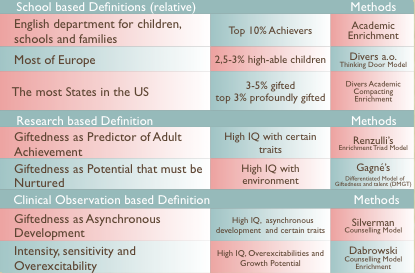There are more than a hundred definitions of high-ability. No single definition of high-ability is accepted by everyone or even by a majority of people. There are several general ways of defining high-ability.

School-Based Definitions
The first is based on schools’ definitions of high-ability, mostly based on the policy of the government’s Department of Education in that country.
Those school-based definitions are relative; at one school a child can be seen as high-able in school and at another, the child is not considered high-able, it can even differ from year to year. It differs between schools, countries and continents.
Research-Based Definitions
The research-based definitions of high-ability are the result of research done into the field of high-ability, influenced by the perspectives of the different researchers. Those definitions are mostly connected with a theory that can be used to enhance or research the situation of high-able pupils and can be applied in research, testing, the classroom, intellectual peer groups or counselling situations.
In general teachers and parents confirm that behaviour and constitution of the high-able differ from their peers.
Clinical Observed Based Definitions
Parts of Clinical Observed Based Definitions are found most practical and often used in supporting high-able children, teenagers and young adults within the PowerWood Community.
The notion of Silverman (2005) of high-ability as an asynchronous development is very helpful in understanding and coaching high-able children and teenagers, and this has been defined by the Columbus Group.
Also very helpful and practical have been the theory and in particular several concepts that are part of Kazimierz Dabrowski’s Theory of Positive Disintegration, which describes how a person’s development grows as a result of accumulated experiences.
Differences
The schools’ definition of high-ability can differ significantly from the professional definition of high-ability and the parents’ definition of high-ability.
These differences in definition can be a cause for concern and confusion for schools, teachers, professionals, parents and pupils, making communication difficult.
In discussing high-ability it is therefore important to be clear about which definition of high-ability is being talked about, or come to an agreement.
Eclectic Approach

A solution-focused eclectic approach towards high-ability has been, until now, most effective.
All developed definitions and their theories deal with other aspects or sides of high-ability and often contribute positively with practical ideas towards meeting the intellectual, social and emotional needs of the high-able.
Emotion Regulation
Multilevel Emotion Regulation Theory (MERT) is a holistic theory developed by Simone de Hoogh. The theory explains how neurodiverse (young) individuals and parents of neurodiverse children can develop emotional regulation skills and direct their energy towards self-chosen goals, and contribute to society.
PowerWood’s Community
Find understanding, tools and strategies that work in an understanding, respectful and compassionate Community.
PowerWood can be your and your families advocate and your second family.
Explore how joining our PowerWood community by becoming a member will benefit you and your family and what types of memberships are available.
Join our Community
Available to Members*
*Booking a one-off Free Introductory Talk of 45-60 minutes by Skype or FaceTime with Senior Consultant Simone de Hoogh is one of the benefits of being either a FreeBee PowerWood Community Member or a Friend PowerWood Community Member.
Book a FREE Introductory Talk with a Professional*
You can read more about PowerWood’s Consultancy Sessions, the Benefits of a Free Introductory Talk and PowerWood’s Consultancy Services Tiered Fee Structure.
*Overexcitability Test
OE (Overexcitability) is an element of a Developmental Theory –Theory of Positive Disintegration by Dabrowski- that is one of the underpinning theories of MERT (Multi-level Emotion Regulation Theory) developed by Simone de Hoogh. Overexcitability explains and allows us to look at ‘extreme’ behaviour as a valuable asset in our or our children’s life.
Find out if you or your child has OE (OverExcitability) as well
*Boundary Test
A HUGE thank YOU to the son and daughter of Ernest Hartmann’s who gave PowerWood permission to use and put the full academically approved questionnaire about the Boundary in the Mind on PowerWood’s website.
Find out how the Boundary in the Mind affects you or your child
